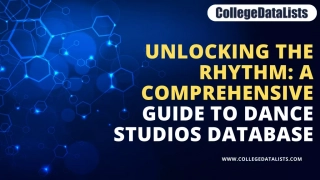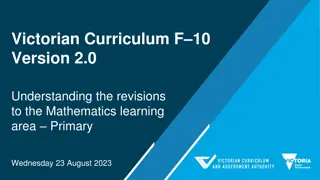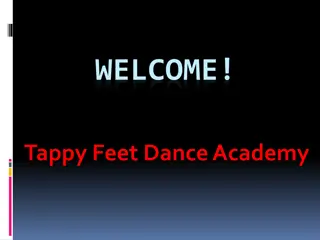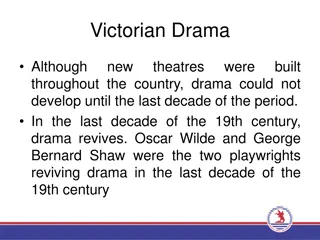Exploring Dance Education in the Victorian Curriculum
Delve into the significance of dance education within the Victorian Curriculum, where students develop creative and expressive capacities by engaging with various dance practices and traditions. The curriculum emphasizes students being both artists and audience members, facilitating a deeper understanding of individual and community identities through dance, drama, music, media arts, visual arts, and visual communication design.
Uploaded on Oct 09, 2024 | 0 Views
Download Presentation

Please find below an Image/Link to download the presentation.
The content on the website is provided AS IS for your information and personal use only. It may not be sold, licensed, or shared on other websites without obtaining consent from the author. Download presentation by click this link. If you encounter any issues during the download, it is possible that the publisher has removed the file from their server.
E N D
Presentation Transcript
Performing Arts in the Real World: Dance Helen Champion Webinar, 25 May 2017
Session overview typical learning activities learning opportunities that are relevant and appropriately challenging research and practice assessment reporting
Where is Dance in the Whole school, Level and Domain plans at your school? On the timetable? Core? Elective? Co-curricula? Embedded in multidisciplinary inquiry/project- based learning? Discussion & Sharing What s happening at your school? Why is it important to know, document and promote this information?
Arts curriculum design Designed for use in multiple contexts Same No set pedagogies, texts or styles framework for all Arts disciplines VICTORIAN CURRICULUM: THE ARTS
Victorian Curriculum: The Arts Strands: explore & express/represent ideas practices present & perform respond & interpret 2 + Organising ideas: students learn as artist and as audience Students learn by making & responding
Whats on the Victorian Curriculum website? Victorian Curriculum index page Curriculum planning resource Navigating the website videos Curriculum area advice
Is there a glossary? And what about the capabilities and cross-curriculum priorities? The Arts landing page In the Victorian Curriculum F 10, the Arts includes Dance, Drama, Media Arts, Music, Visual Arts and Visual Communication Design. The Arts enable students to develop their creative and expressive capacities by learning about the different practices, disciplines and traditions that have shaped the expression of culture locally, nationally and globally. Students are both artist and audience in the Arts. They make and respond and learn to appreciate the specific ways this occurs in different disciplines. The Arts present ideas that are dynamic and rich in tradition. Through engaging in The Arts students are entertained, challenged and provoked to respond to questions and assumptions about individual and community identity, taking into account different histories and cultures. The Arts contributes to the development of confident and creative individuals and enriches Australian society. Students express, represent and communicate ideas in contemporary, traditional and emerging arts forms. In Dance, Drama and Music students explore the performing arts whilst in Media Arts, Visual Arts and Visual Communication Design students explore the world of visual representation and expression. The significant contributions of Aboriginal and Torres Strait Islander peoples to Australia s arts heritage and contemporary arts practices are explored across the Arts, and students are encouraged to respect and value these unique and evolving traditions. Learning areas & capabilities Koorie Cross-curricula protocols Aboriginal languages: sample units Creative Spirits, Melbourne Festival Tanderrum, Dreamtime at the G
Whats typical in Dance? Learning dance knowledge, skills and understandings, aka, dance practice, being a dancer Learning process: opportunities to learn mediated by prior learning and personal experiences, the school instructional model, the curriculum framework, assessment practice Learning outcomes: Students are able to express, question and celebrate human experience, using the body as the instrument and movement as the medium for personal, social, emotional, spiritual and physical communication . [VC, The Arts Dance, Rationale]
Whats typical in Dance? Starting points: styles, techniques/skills, themes, performers, improvising Learning intentions, pedagogies, formative and summative assessment, curriculum content: Explore and express ideas, practise dance, present and perform, interpret and respond Students who have dance knowledge, skills and understandings and are able to contribute to their communities as dancers, choreographers and audiences promoting wellbeing and social inclusion.
Typical starting points? directed warm-up structured improvisation technique skill-development dance on screen analysis iconic performers styles EXPLORE & EXPRESS PRACTICES PRESENT & PERFORM RESPOND & INTERPRET
Curriculum designed as a continuum v non-continuous student access to learning Issues Level v year 2 year bands Catering for the range of experience in the classroom/studio Electives Reporting On the VCAA website Curriculum design Dance Scope & sequence EXPLORE & EXPRESS PRACTICES Research and resources (an incomplete sample) Essential teaching practices Australian Dance Theatre Chunky Move ETC Rainbow Vomit PRESENT & PERFORM RESPOND & INTERPRET
Opportunity to learn 1- 2 3 - 4 5- 6 7- 8 9- 10 F Continuous opportunities to learn provided across F-10 Increases likelihood that1:1 relationship between curriculum level and year level can be maintained
Which level? 1- 2 3 - 4 5- 6 7- 8 9- 10 F If students only access to Dance learning happens when they are in Year 7, which curriculum level should their learning program be based on, and, which level should they be expected to achieve?
Which level? 1- 2 3 - 4 5- 6 7- 8 9- 10 F F 1-2 3 - 4 5-6 7-8 9-10 VCE Or, if these students are in the same class?
F-6 in a semester? Explore and express ideas Use fundamental locomotor and non-locomotor movements, body parts, bases and zones to explore safe movement possibilities and dance ideas Learning activities Stimulus: Use safe dance practice, fundamental locomotor and non-locomotor movements, body parts, bases and zones to explore, improvise and structure movement ideas for dance Rainbow Vomit by Dance North Improvise and structure movement ideas for dance sequences using safe dance practice, the elements of dance and choreographic devices Explore movement possibilities and choreographic devices using safe dance practice, the elements of dance to create movement ideas, sequences and phrases Exploring through structured improv shapes use of space Patterns Practising skills, techniques, processes Presenting Soundtrack and production elements Responding Use of shapes, space & patterns Student and professional dancers
with 7-10 happening too? Explore and express ideas Learning activities 7-8 Use safe dance practice, elements of dance, body actions and improvisations to explore ways of making literal movements into abstract movements Create a work in response to Dance North s Rainbow Vomit Develop their choreographic intent by applying the elements of dance to select and organise movement Interpret shapes, phrases Respond to ideas and movements Explore time, space, relationships, dynamics, production possibilities Practise dance-making, using choreographic devices, abstracting, forming phrases and sequences, documenting Perform Respond and evaluate 9-10 Explore personal movement style by combining elements of dance and using improvisation and safe dance practice to develop new movement possibilities Manipulate combinations of the elements of dance and choreographic devices to communicate their choreographic intent
Planning questions Why is this activity in the learning plan for this student/group of students? What are the key concepts the students will learn? How will you know what students already know and what learning has occurred? How does the activity mesh with the school instructional model ? EXPLORE & EXPRESS PRACTICES PRESENT & PERFORM RESPOND & INTERPRET
More planning questions How is the activity introduced? taught? aligned to prior learning? varied to cater for different levels of knowledge and skill? How does the activity connect to the rest of the unit/sequence? What opportunities are there for formative assessment? self-assessment peer-assessment teacher observation EXPLORE & EXPRESS PRACTICES PRESENT & PERFORM RESPOND & INTERPRET
Sequencing and developing Dance Achievement Standards Rainbow vomit make and perform dance sequences and demonstrate safe dance practice. Students describe what happens in dance they make, perform and view F use the elements of dance and fundamental movement skills to make and perform safely, dance sequences that express ideas. Students communicate about dances they make, perform and view, and discuss where and why people dance 1-2 structure movements into dance sequences and use the elements of dance and choreographic devices to communicate their ideas and intentions. They make dances and perform safely with control, accuracy, projection and focus. Students describe and discuss similarities and differences between dances they make, perform and view. They discuss how they and others organise the elements of dance to communicate ideas and intentions. 3-4 structure movements in dance sequences and use elements of dance and choreographic devices to make dances that communicate ideas and intentions. They perform dances for audiences, demonstrating technical and expressive skills and safe dance practice. Students explain how the elements of dance, choreographic devices and production elements communicate ideas and intentions in dances they make, perform and view. They describe characteristics of dances from different social, historical and cultural contexts and discuss how these influence their dance making 5-6 choreograph and perform dances to communicate ideas and intentions. They improvise movement and select and organise the elements of dance, choreographic devices and form to communicate choreographic intent. Students learn, rehearse and perform dances, demonstrating technical and expressive skills appropriate to the dance style and safe dance practice. Students identify and analyse the elements of dance, choreographic devices and production elements of dances in different styles and apply this knowledge to dances they make and perform. They evaluate how they and other dance practitioners from different cultures, times and locations, communicate ideas and intentions through dance. 7-8
Reporting Check the Guidelines and advice from your school sector Report against the Achievement Standards, not the content descriptions Develop an approach that Recognises how many opportunities there are to report on learning in Dance Which level? How will progress be shown? Acknowledgesstudents prior learning (or lack thereof) Focus on the dance and keep it relevant Use language from the curriculum Refer to class activities If possible, make the report interactive by including/linking to evidence from student s self-assessments, peer observations etc.
Feedback Please complete the survey the F-10 unit will email to you so that I get your feedback about the relevance of this presentation for your work and whether it met your expectations. You can also email me directly: Helen Champion Curriculum Manager: Performing Arts phone: 61 3 9032 1723 email: champion.helen.h@edumail.vic.gov.au























